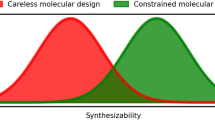Summary
The fragment placement method has been successfully extended to the problem of envelope-directed design. The atom assignment paradigm was based on molecular similarity between two molecular structures. A composite supersurface is defined to form the surface onto which the molecular fields are projected. The assignment process is then determined by using molecular similarity in the objective function to be optimized. In principle, this procedure is closely similar to that outlined in the previous paper for site-directed design. The rationale has been extensively tested on two benzodiazepine antagonists believed to bind to the same site.
Similar content being viewed by others
References
Dean, P.M. (Ed.) Molecular Similarity in Drug Design, Blackie Academic and Professional, London, 1995.
Cramer, III, R.D., Patterson, D.E. and Bunce, J.D., J. Am. Chem. Soc., 110 (1988) 5959.
Kim, K.H., In Dean, P.M. (Ed.) Molecular Similarity in Drug Design, Blackie Academic and Professional, London, 1995, pp. 291–331.
Perkins, T.D.J. and Dean, P.M., J. Comput.-Aided Mol. Design, 7 (1993) 155.
Barakat, M.T. and Dean, P.M., J. Comput.-Aided Mol. Design, 9 (1995) 341.
Barakat, M.T. and Dean, P.M., J. Comput.-Aided Mol. Design, 9 (1995) 351.
Barakat, M.T. and Dean, P.M., J. Comput.-Aided Mol. Design, 9 (1995) 359.
Barakat, M.T. and Dean, P.M., J. Comput.-Aided Mol. Design, 9 (1995) 448.
Lewis, R.A. and Leach, A.R., J. Comput.-Aided Mol. Design, 8 (1994) 467.
Codding, P.W. and Muir, A.K.S., Mol. Pharmacol., 28 (1985) 178.
Bertolasi, V., Ferretti, V., Gilli, G. and Borea, P.A., Acta Crystallogr., C, 40 (1984) 1981.
Burkert, U. and Allinger, N.L., Molecular Mechanics, ACS Monograph Series, Vol. 177, American Chemical Society, Washington, DC, 1982.
Borea, P.A., Dean, P.M., Martin, I.L. and Perkins, T.D.J., Mol. Neuropharmacol., 2 (1992) 261.
Barakat, M.T. and Dean, P.M., J. Comput.-Aided Mol. Design, 5 (1991) 107.
Author information
Authors and Affiliations
Rights and permissions
About this article
Cite this article
Barakat, M.T., Dean, P.M. The atom assignment problem in automated de novo drug design. 5. Tests for envelope-directed fragment placement based on molecular similarity. J Computer-Aided Mol Des 9, 457–462 (1995). https://doi.org/10.1007/BF00124003
Received:
Accepted:
Issue Date:
DOI: https://doi.org/10.1007/BF00124003




